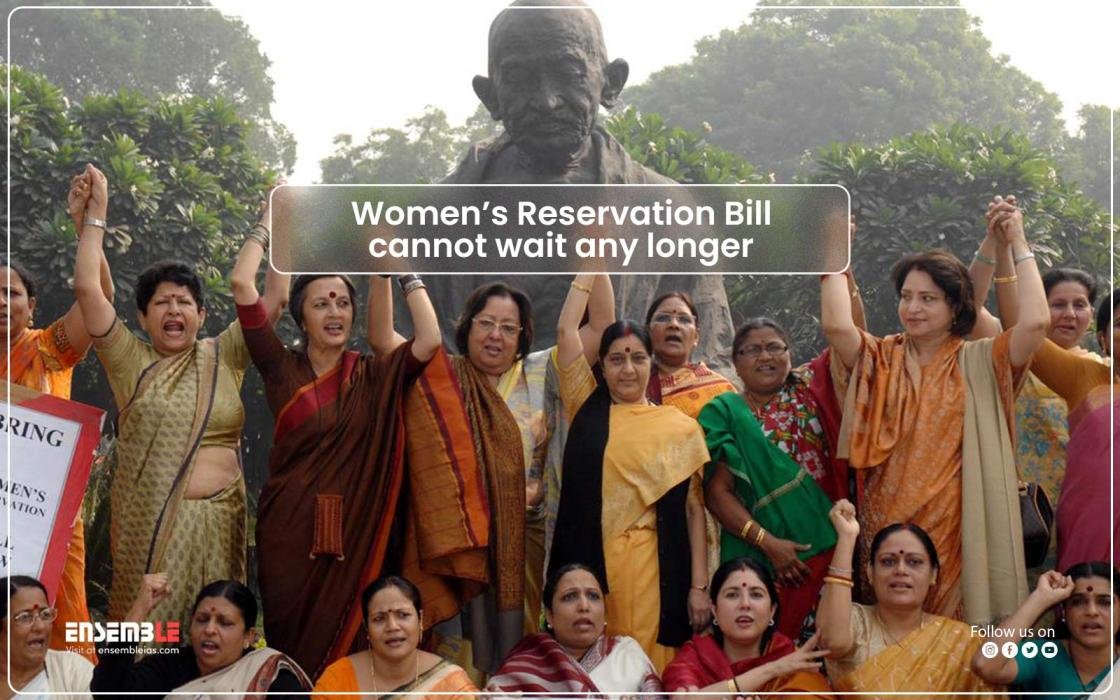Context- The Rajya Sabha passed the Women’s Reservation Bill on 9 March 2010. However, the Lok Sabha never voted on the bill. The bill lapsed since it was still pending in Lok Sabha.
About Women’s Reservation Bill-
– The Constitution 108th Amendment bill, 2008 seeks to reserve one-third (33%) of all seats for women
in the Lok Sabha and the state legislative assemblies. The allocation of reserved seats shall be
determined by such authority as prescribed by Parliament.
– Reserved seats may be allotted by rotation to different constituencies in the state or union
territory.
– Reservation of seats for women shall cease to exist 15 years after the commencement of this
Amendment Act.
– One-third of the total number of seats reserved for Scheduled Castes and Scheduled Tribes shall be
reserved for women of those groups in the Lok Sabha and the legislative assemblies.
Historical Background-
– The issue of reservation for women in politics was a long-back demand since 1931. Formed a women’s
body constitute of two -Begum Shah Nawaz and Sarojini Naidu -submitted a memorandum issued on the
status of women to the British Prime Minister.
– In 1955, the Government appointed a committee that recommended that 10% of seats in the Lok Sabha and
state legislature should be reserved for women.
– National prospective plan for Women (1988) recommended that 30% of seats should be reserved for women
in all elected bodies. This plan provides women’s rights from the level of the panchayat to that of
the parliament.
– Historic enactment of 73rd and 74th amendments to the constitution which mandate all state
governments to reserve one-third of seats for women in panchayat raj institutions and one-third of
the office of the chairperson at all levels of the in-panchayat raj institutions and in the urban
local bodies. Within these seats, one-third is reserved for SCs/STs women.
– Some states such as Maharashtra, Andhra Pradesh, Bihar, Chhattisgarh, Jharkhand and Kerala have made
50% reservations for women in local bodies.
Women ‘s status
– Women’s representation in Lok Sabha and Rajya Sabha remains a mere 14.44 %and 10.5% respectively.
– India’s sex ratio at birth is 898 girls per 1000 boys.
– India still has among the highest number of maternal and infant mortality in the world.
– According to NCRB, the Substantial rise in structural and physical violence against women.
– The average wage for women remains at 70% of their male colleagues.
– Female labour participation rate according to the economic survey 2022-23 is pegged at 25.1% in2020-
21.
– India ranked 135th in Global Gender Gap Index 2022
![]()
Legislation to provide equal opportunity to women and secure their safety and dignity-
– Protection of Women from Domestic Violence Act (2005).
– Sexual harassment of women at the workplace (Prevention, Prohibition and Redressal) Act 2013.
– Prohibition of Child Marriage Act (2006).
– The Equal Remuneration Act 1976.
– In 2015, an amendment to laws on the rights of Hindu women to property and inheritance.
Key issue or challenge-
– Divergent view on reservation policy -a social mindset that refused to acknowledge women as leader
– Opponents argued that women are not perceived to be competing on merits.
– Restrict the choice of voters.
– Rotation policy for the reservation to women may reduce the incentive for an MP to work for his
constituency.
Why India Needs the Women’s reservation bill-
– Equal representation of women in legislation can significantly improve the quality of decision-making
and empower both women and the nation.
– To ensure that women from a strong lobby in parliament fight for issues that are often ignored.
– To empower them to identify and break cultural barriers to improve socio-economic conditions.
– Women’s capacity to take up their new responsibility as legislators or MPs.
– Develop women’s leadership and their leadership skills for enhancing social mobilization.
– Enhance the participation of women in governance in higher numbers.
– Global Gender Gap report, Bangladesh (score 0.546) ranks 9 and India stands at 48th (score 0.267)
reflecting a lower level of female participation in politics. Country’s larger picture of gender
inequality.
– Cannot achieve social development with equity and justice without equal representation of women in
parliament.
– Goal 5 of SDGs – India declared commitment to women’s lead development.
– Weak in bargaining power in labour market.





